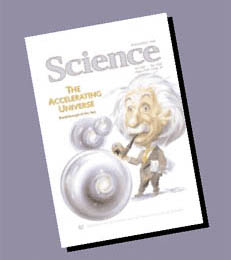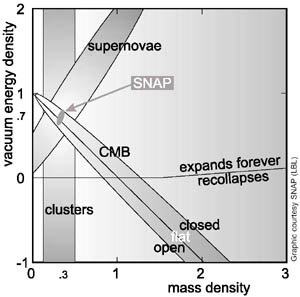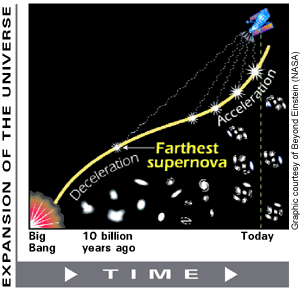 |

A Little History
To search for the explanation for dark energy, cosmologists need better measurements of how it has evolved over time. Using the Hubble Space Telescope plus several terrestrial telescopes, the SCP has now plotted over 50 supernovae, but the next generation of precision measurements requires new instruments. The HST can only detect a handful of supernovae in the time devoted to this project, and the atmosphere hampers ground-based observations by absorbing light coming from supernovae at redshifts above z=1 (or 7 billion light years away). In 1999 Perlmutter decided that only a dedicated space-based telescope could give them the required capabilities, and his group began designing SNAP. SNAP has many prime selling points. With a 2-meter aperture, it would see very faint supernovae. The half-billion-pixel digital camera covering one square degree of sky at a time (considered "wide-field") would discover large numbers of the explosions, which occur in each galaxy about once per century. Near-infrared detectors would pick up light at wavelengths beyond the visual spectrum, extend-ing the telescope's reach to z=1.7, mapping the expansion history of the universe over the last 10 billion years. A spectrograph would analyze each event in enough detail to provide a thorough characterization of each supernova (a "supernova CAT-scan"). And on-board filters giving data in nine wavelength bands would account for any dimming due to galactic dust. No single supernova has undergone all of these measurements before, and SNAP would analyze 2000 of them a year. In addition to studying type Ia supernovae, the probe would also analyze type II supernovae, survey galaxy clustering, and compile unprece-dented measurements of a phenomenon called gravitational lensing whereby matter-even dark matter-in the line of sight of more distant objects will distort their images. There's also a concept that Pelrmutter calls "not so innovative but cute to look at": an integral field unit spectrograph that would produce a 3-dimensional data cube with the x and y coordinates making up two dimensions, and wavelength making up the third.
DOE and NASA Team Up
The two organizations took the recommendation seriously and teamed up to form the Joint Dark Energy Mission, or JDEM. A dark energy mission also fit directly into NASA's new Beyond Einstein program, designed to study the Big Bang, dark energy, and black holes, including plans for two space-based observatories, three space probes, plus other programs. The probes will launch every 3 years beginning in the next decade. One probe has been designated a dark energy probe. In October 2003, DOE and NASA released a proposal outlining how they will work together on the JDEM collaboration. NASA will do the space mission management. The dark energy investigation, including scientific payload and investigation, will be a Primary Investigator-led effort. In three years NASA and DOE will choose the winning scientist-led team for JDEM. SNAP is a contender. In November, NASA selected five mission concepts to fund for further study. Three of them involve SNAP, one is for technology development, and one involves a project called DESTINY, led by Jon Morse at Arizona State University. JDEM has brought together the two very different cultures of NASA and DOE. NASA for example, uses large contractors to do much of the work and places a small team of scientists at the top of a project. DOE, on the other hand, uses large self-organizing collaborations of scientists, who lead the project. Kathy Turner, Program Manager in the Office of High Energy Physics at DOE's Office of Science says that a precision instrument like a dedicated dark energy probe requires everyone to work closely, in a hands-on fashion: If you change widget A, will it change the science? But the mission size, and the need to go into space, require that they work in a different mode. "Neither DOE nor NASA could do the project alone," she said. Paul Hertz, the Program Scientist for Beyond Einstein at NASA Headquarters, added: "There are a huge number of cultural conflicts, but they don't keep us from working together well." Both organizations gained important insight from recent collaboration on SLAC's Gamma Ray Large Area Space Telescope.
"The GLAST collaboration has been a wonderful learning opportunity for both of us," said Hertz. "We understand each other's way of doing business now." Such cooperation indicates a new spectrum of possibilities as the two cultures learn to combine their strengths. In November the Secretary of Energy Spencer Abraham, released "Facilities for the Future of Science: A Twenty-Year Outlook." JDEM tied for third place in scientific importance and readiness for construction.
Fermilab Steps In
Fermilab began preliminary work on the project 18 months ago. Diehl has been working on the radiation shielding for about a year. The shield must block visible light, infrared heat and cosmic rays. When Diehl designed shielding for DZero, each bus-sized shield weighed 110 tons, but for this project he cannot go above 20 kilograms. "The best we can do is not make things worse" by turning the cosmic rays into particle showers, Diehl said. Steve Kent and Doug Tucker are working with LBL's calibration team to account for all of the systematic errors that might alter the brightness of the supernovae. Their experience with Sloan will help them avoid certain mistakes. "Once a satellite is launched," Kent said, "you have no opportunity to go back and fix or change anything. A big advantage of space, fortunately, is that one does not need to look through the earth's atmosphere with its variable clouds, haze, and dust that afflict ground based observations." The SNAP satellite would collect more than 100 gigabytes of data each day. "This requirement would be significant for a land-based system but represents an enormous challenge for a satellite," Marriner said. The Electronics group evaluates the memory technologies, data compression algorithms, and computing hardware required to record the data, compress it, and send it back to Earth. Each area of electronics R&D has its own special hurdles. The group is exploring flash memory chips, which don't require power to store data but in the past have shown poor radiation tolerance. They're pushing outside the realm of traditional data compression algorithms and testing novel schemes for prescaling data to reduce the amount of bits sent to the ground. So far, their computing chips have shown a high sensitivity to radiation. The computing systems must be light, and they must be efficient enough to require little power, and robust enough to survive bombardment from cosmic particles. Limon sees SNAP fitting into a potential long-range plan as Fermilab extends its areas of research into space. SNAP could become a flagship project. "We have a worldwide reputation for excellence in experimental cosmology," Dodelson said. "Fermilab is not only an accelerator lab. It is really a fundamental physics lab. I see this as completely consistent with Fermilab's mission." Further, the lab's role in the Sloan Digital Sky Survey has provided experience in astronomy and cosmology, as well as the science and techniques of wide-field astronomical observations. "Fermilab found a lot of new ways to use the wide-field data," Perlmutter said, "and that's a testament to the creativity of the team. It made a natural match."
Limon summarized the three compelling reasons
to join the collaboration:
"There's a lot of work between now and then," he emphasized. On the Web:
Lawrence Berkeley National Laboratory |
| last modified 12/31/2003 email Fermilab |
FRLsDFx9eyfrPXgV


